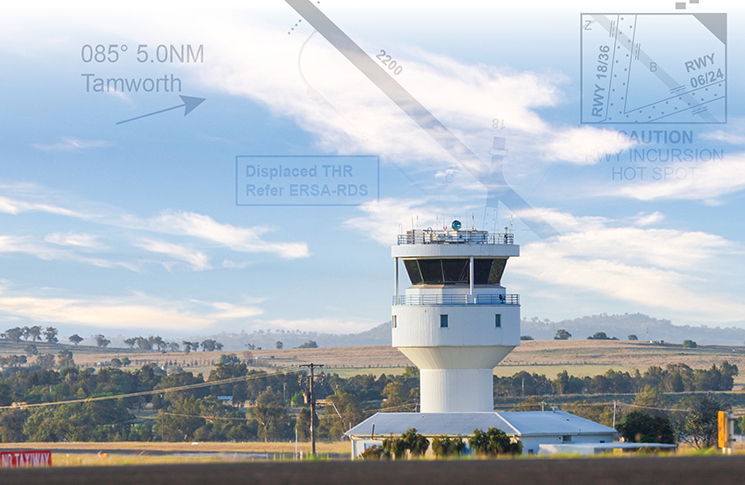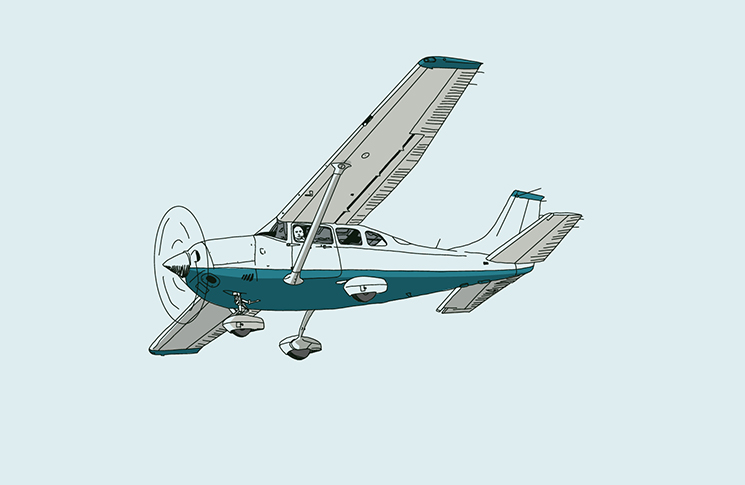Even the most seasoned pilots can get nervous when approaching a busy, controlled aerodrome. Whether you’re a fresh commercial pilot or a weekend warrior, this analysis of 8 common mistakes (and their solutions) will help you confidently navigate the airspace.
1. The ‘mic fright’ freeze
We’ve all been there. You’ve rehearsed the radio call but when it’s time to press the transmit button, your mind goes blank. You turn your head to the instructor with a frightened face – and, like Maverick, they save you with a confident readback. Whether you’re a student or a licensed pilot, there can always be a level of anxiety when talking to air traffic control – and it affects more pilots than you’d think!
Steve Reh, senior grade 1 flight instructor and examiner at ALTOCAP Flight School, says radio anxiety is quite common among students and new pilots, especially in the early stages of their training.
‘New pilots are often afraid of sounding unprofessional or making errors on the radio, leading to hesitation and overthinking when communicating with ATC or other aircraft,’ he says.
‘Other things include unfamiliarity with procedures, pressure of multitasking and perceived judgement. Flying requires a lot of concentration and adding radio communication on top of that can overwhelm new pilots.
‘Many fear being judged by ATC or other, more experienced pilots for not sounding confident or smooth on the radio. Radio calls require confidence and quick decision-making – both of which come with practice and experience.’
The fix: Reh says it’s good practice to rehearse radio calls on the ground before making them in the air. ‘Start with simple situations and work up to more complex ATC exchanges,’
he says. ‘You can even tune into a live ATC app and listen to inbound and outbound calls in real time to get a sense of the way calls should be made.’
CASA recommends following the format of what, who, where intentions for radio calls:
- what: the station you’re calling
- who: your callsign
- where: your position/location
- intentions: what you plan to do.
Pro-tip for newbies: Create a small card with standard phraseology for your most common calls. Carrying a ‘cheat sheet’ might prevent situational forgetfulness for private pilots who rarely fly into controlled airspace.
2. Readback ramble
Rushing through readbacks is a recipe for disaster.
Melbourne-based air traffic controller Scarlett McNab, says, ‘When a pilot doesn’t read [back] the required elements of a clearance, it can cause a significant delay in ATC actioning other tasks or outstanding requests.’
She says chasing a pilot for a callsign is annoying for everyone.
‘When a pilot is consistently missing parts of their readbacks, it causes concern about their understanding of the clearance and can lead to ATC being restrictive with level changes or routing requests to ensure there’s no compromise to safety.’
Regulations and radio procedures require certain elements to be read back in full, including:
- all runway-related clearances
- level restrictions, direction of turn and headings
- QNH settings
- SSR codes
- frequency instructions
- route and approach clearances.
The fix: Write down complex clearances but don’t be afraid to use that magic phrase, ‘say again’ if you didn’t catch all the information.
Also, be sure to avoid these common readback errors:
- partial readbacks of critical instructions
- mumbling numbers or letters
- using non-standard phraseology
- mixing up similar-sounding numbers.
3. Taxiway tangle
Getting lost on the ground is more common than getting lost in the air at controlled airports. If you’re taxiing around an unfamiliar airport, ensure you take extra care to read the taxiway signs correctly.
CASA’s guidelines for ground operations place emphasis on:
- maintaining a sterile cockpit during taxi
- having airport diagrams readily available
- understanding all taxiway signage and markings
- being prepared to stop if unsure of position.
It happened to me: I remember being a student pilot and returning from a solo flight. I decided to re-taxi for circuits. I’d only done this with my instructor before. I sat at the holding point until the controller gave me circuit clearance. Then, I crossed the holding point and started taxiing the usual route to the next holding bay. I only got round the bend when he blared: ‘[Callsign], what are you doing? You can’t just be taxiing around the airport without a clearance.’
I was mortified and confused because I thought he cleared me. I hit the button and explained myself. ‘I did clear you for circuits, but not to taxi,’ was the reply. I wanted to vaporise, but it was a lesson learnt in following correct procedures.
The fix:
- study the airport diagram before flight
- keep it handy during taxi
- if unsure of your position, stop and ask for ‘progressive taxi’ instructions
- brief yourself on hot spots and known areas of the aerodrome that have caused confusion.
Tip to tango (not tangle) on the taxiway: Many controlled aerodromes have published standard taxi routes. Familiarise yourself with these before arrival.
4. Clearance confusion
Hearing what you expect to hear – rather than what ATC actually said – often happens with similar-sounding runway numbers or altitude. Even when you’re familiar with the airspace and assume you’re going to receive the usual clearance, you can still make an error if you’re not actively listening to the call.
‘Misheard clearances are one of the biggest issues for ATC and they are one of the reasons we focus so heavily on acknowledging and confirming readbacks when training new controllers,’ McNab says. ‘Clear and precise readbacks ensure safety and efficiency. Reading the clearance back in the same order the ATC gives it allows us to see if a part of the clearance is missing.
‘For example, if the ATC says, “Cleared to Perth via RULVI, flight planned route, climb to flight level 350” and the readback is, “Cleared to climb to flight level 350, flight planned route to Perth via RULVI”, it’s harder for the ATC to ensure that all the required parts are there.’
Safety guidance emphasises:
- always having a pen and paper ready
- writing down complex clearances
- reading back critical instructions
- questioning anything unusual
- monitoring ATIS before initial contact.
Common clearance confusion scenarios include:
- misinterpreting ‘line up and wait’ as ‘cleared for take-off’
- confusing similar runway numbers where multiple runways exist
- mishearing altitude restrictions
- misunderstanding conditional clearances.
The fix:
- develop a systematic approach to receiving clearances
- maintain situational awareness – be present to what you’re doing
- use a notepad or EFB for writing clearances
- crosscheck with your flight planning documents
- brief expected clearances before calling ATC.
5. Pattern panic
Joining a busy circuit pattern while juggling radio calls, checklists and spotting traffic can be a daunting experience. If you catch yourself looking for the ‘eject’ lever, reach for the cockpit creed instead: aviate, navigate, communicate.
Reh says there are several common mistakes that student pilots make when entering a circuit. ‘These errors can lead to confusion, unnecessary stress, and other safety concerns,’
he says.
‘It’s crucial for instructors to provide clear guidance on the correct entry procedures, emphasise situational awareness, and foster a calm, methodical approach to pattern flying.
I was mortified and confused because I thought he cleared me.
‘By gradually increasing complexity and helping students gain confidence in their abilities to enter and fly circuits, instructors can ensure students develop good habits that
will keep them safe and efficient in the circuit.’
Circuit procedures require:
- maintaining standard circuit height
- proper spacing from other aircraft
- correct radio position reporting
- adhering to published circuit direction.
The fix:
- brief circuit procedures before departure
- have radio calls written down
- use a circuit entry plan
- know your aircraft’s performance numbers
- practise emergency procedures regularly.
Circuit management tips:
- plan power settings for each leg
- use visual references for consistent patterns
- monitor wind drift correction
- keep track of aircraft ahead and behind.
6. Speed stumble
ATC are there to make everyone’s life easier. They understand the challenges of flying in a small aircraft like an Extra and attempting to slot in behind a Sling while a King Air is breathing down your neck.
‘Speed management is one of the easiest ways to achieve appropriate spacing over a long distance,’ McNab says. ‘However, if ATC are given incorrect information, it can lead to potential issues with separation plans. Changes of only 20 to 30 knots ground speed can make a big difference and allow aircraft to fly their preferred approaches when landing at the same aerodrome.’
Speed management strategies:
- know your aircraft’s approach speeds
- plan power settings for different configurations
- use flaps effectively for speed control
- maintain situational awareness of surrounding traffic.
7. Documentation dilemma
There’s nothing worse than showing up to the aerodrome to find that the runway has been temporarily closed, and you have to hold or head to an alternate for fuel. Or perhaps you were anticipating landing on a particular runway, but there’s been a runway change and you’ve been caught off guard because of it.
Arriving at a controlled aerodrome without checking the ATIS, NOTAMs, weather or having the correct charts ready makes you the safety concern in the airspace, so you must plan accordingly.
Required documentation for landing at controlled aerodromes:
- current aerodrome charts
- ERSA pages
- NOTAMs
- weather briefing
- valid licences and medical certificates (can be digital)
- aircraft documents.
The fix:
- check NOTAMs for the departure and arrival aerodromes
- review weather forecasts and reports
- verify radio frequencies
- check runway and taxiway closures
- review noise abatement procedures
- check ATIS.
8. The ‘I’m too cool to ask’ syndrome
Pride can be a pilot’s worst enemy. Mistakes stem from not wanting to admit uncertainty or ask for clarification.
‘I let pilots know when I make mistakes or haven’t understood a request,’ McNab says. ‘I want them to know they can ask anything because not asking for clarification is a surefire way to end up in a mess at some point.
‘Controllers would rather be asked questions at the start than deal with the potential safety issues from misunderstandings.’
The fix:
- ask questions before they become problems
- share experiences with other pilots
- report safety concerns through proper channels.
Scenarios when it is crucial to ask questions:
- unclear clearances
- unfamiliar procedures
- weather decisions
- equipment malfunctions
- circuit confusion.
Prepare for Landing
Controlled airports are designed to make flying safer and more efficient, but only if we use them correctly. Remember, controllers are there to help, not to judge. They want you
to succeed just as much as you do.
‘My sole job is to ensure that pilots can get safely from A to B,’ McNabb says. ‘I go to work every day to ensure they are safe in their operations. ATCs are here to help as much as needed. We can make the skies safe for everyone, as long as we put our trust in each other.’
Safety in aviation is about continuous improvement, not perfection. Every flight is a learning opportunity; every mistake is a chance to become a better pilot.





